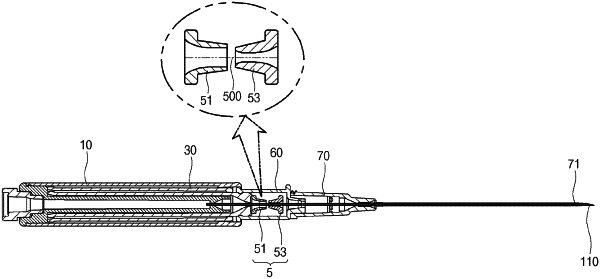| CPC A61M 25/0631 (2013.01) [A61M 2205/273 (2013.01)] | 7 Claims |

|
1. A reuse prevention safety catheter, the catheter comprising:
a catheter hub having an external needle disposed on the catheter hub;
a cannula plug having an internal needle insertable and penetrable into the catheter hub and disposed on the cannula plug to introduce the external needle into a blood vessel and to be separated from the catheter hub; and
a locking guide unit having a through-hole configured to allow the internal needle to pass through,
wherein the through-hole is deformed when the internal needle is withdrawn, such that re-penetration of the internal needle is blocked,
wherein the locking guide unit comprises a first locking guide and a second locking guide, each of the first locking guide and the second locking guide having a truncated conical shape with an eccentric center of gravity and configured such that when the internal needle is withdrawn from the through-hole, an inclination in the first locking guide and the second locking guide is generated within an angular range of greater than 0° and less than 90° by gravity to change a position of the through-hole,
wherein the first locking guide and the second locking guide each have a gradually decreasing diameter at respective ends of the first locking guide and the second locking guide, and
wherein the second locking guide is located distal to the first locking guide, and the first locking guide and the second locking guide are symmetrically disposed with the respective ends of the first locking guide and the second locking guide opposite each other so that when the internal needle is first withdrawn from the second locking guide, the end of the second locking guide is lowered so that a symmetrical disposition becomes a staggered disposition and a path of the through-hole is changed.
|